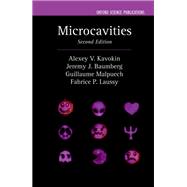
Microcavities
by Kavokin, Alexey V.; Baumberg, Jeremy J.; Malpuech, Guillaume; Laussy, Fabrice P.Buy New
Rent Textbook
Rent Digital
Used Textbook
We're Sorry
Sold Out
How Marketplace Works:
- This item is offered by an independent seller and not shipped from our warehouse
- Item details like edition and cover design may differ from our description; see seller's comments before ordering.
- Sellers much confirm and ship within two business days; otherwise, the order will be cancelled and refunded.
- Marketplace purchases cannot be returned to eCampus.com. Contact the seller directly for inquiries; if no response within two days, contact customer service.
- Additional shipping costs apply to Marketplace purchases. Review shipping costs at checkout.
Author Biography
Alexey V. Kavokin, Chair of Nanophysics and Photonics, Physics and Astronomy, University of Southampton, UK,Jeremy J. Baumberg, Director of NanoPhotonics Centre, Cavendish Laboratory, University of Cambridge, UK,Guillaume Malpuech, Senior CNRS Researcher and head of the photon department of the Institut Pascal, University Blaise Pascal, France,Fabrice P. Laussy, Ramon y Cajal Researcher, Universidad Autonoma de Madrid, Spain
Alexey Kavokin graduated from St-Petersburg Polytechnic University in 1992, PhD in Physics at the Ioffe Institute of Russian Academy of Sciences, 1993. In 1998-2005 he was a professor at the Blaise Pascal University, Clermont-Ferrand, France. Since 2005 he has been Professor and Chair of Nanophysics and Photonics at the University of Southampton, UK. Since 2010 he has been Scientific Director of the Mediterranean Institute of Fundamental Physics (Rome, Italy). He was Principal Investigator at the St-Petersburg State University (2011-2016), and since 2014 he has been Director of Research at the National Council for Research (Italy).
Jeremy J. Baumberg FRS directs a UK Nano-Photonics Centre at the University of Cambridge and has extensive experience in developing optical materials structured on the nano-scale that can be assembled in large volume. He is also Director of the Cambridge Nano Doctoral Training Centre. Strong experience with Hitachi, IBM, his own spin-offs Mesophotonics and Base4, as well as strong industrial engagement give him a unique position to combine academic insight with industry application in a two-way flow. With over 15000 citations, he is a leading innovator in NanoScience. This has led to awards of the Royal Society Rumford Medal (2014), IoP Young Medal (2013), Royal Society Mullard Prize (2005), the IoP Charles Vernon Boys Medal (2000) and the IoP Mott Lectureship (2005). He frequently talks on NanoScience to the media, and is a strategic advisor on NanoTechnology to the UK Research Councils.
Guillaume Malpuech received an engineering degree from Ecole Centrale de Lyon in 1998, and a PhD in Physics from University Blaise Pascal (UBP) in 2001, Habilitation Thesis (2005). Between 2002-2012 he was a CNRS researcher at LASMEA -- Joint Unity of CNRS and UBP. Since 2005 he has been head of the group of Quantum Optoelectronics at LASMEA. Since 2012 he has been Senior CNRS researcher at the Institut Pascal, and since 2015 head of the Photon department of the institute. He is a known theoretician in the field of polaritonics with a large collaborative activity with leading experimental groups. He worked on polariton based optoelectronic devices, spinor quantum fluids of light, photonic analogues of cosmologic and solid state systems.
F.P. Laussy is head of the quantum polaritonic group at the Universidad Autonoma de Madrid (Spain) where he leads the research efforts as the PI of various projects (POLAFLOW, SQUIRREL, CLAQUE). He graduated from Universite Blaise Pascal in 2005, after which he obtained post-doc experience in Sheffield, Madrid and Southampton. He was a Marie Curie fellow at the Technische Universitat Munchen. He made seminal and pioneering descriptions of microcavity polaritons in their Bose-Einstein condensation, superfluidity, and superconductivity. His research groups recently proposed two new kinds of lights, one quantum -- a laser of N-photon states, emitting all its light in packets of N photons with tunable integer N, -- and the other classical -- Full-Poincare temporal beams, or pulses of light taking all the states of polarization.
Table of Contents
1. Overview of microcavities
2. Classical description of light
3. Quantum description of light
4. Semi-classical description of light-matter coupling
5. Quantum description of light-matter coupling in semiconductors
6. Weak-coupling microcavities
7. Strong coupling: resonant effects
8. Strong coupling: polariton Bose condensation
9. Spin and polarisation
10. Quantum fluids of light
11. Quantum polaritonic
12. Polaritonic devices
Appendix A: Scattering rates of polariton relaxation
Appendix B: Derivation of the Landau criterion of superfluidity and Landau formula
Appendix C: Landau quantization and renormalization of Rabi splitting
Index
An electronic version of this book is available through VitalSource.
This book is viewable on PC, Mac, iPhone, iPad, iPod Touch, and most smartphones.
By purchasing, you will be able to view this book online, as well as download it, for the chosen number of days.
Digital License
You are licensing a digital product for a set duration. Durations are set forth in the product description, with "Lifetime" typically meaning five (5) years of online access and permanent download to a supported device. All licenses are non-transferable.
More details can be found here.
A downloadable version of this book is available through the eCampus Reader or compatible Adobe readers.
Applications are available on iOS, Android, PC, Mac, and Windows Mobile platforms.
Please view the compatibility matrix prior to purchase.
